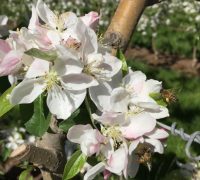Current projects
Solitary bee microbiomes
Solitary bees, like many organisms, require an often specific microbiome for successful development. Unlike social bees (such as honeybees) solitary bees have no transmission of a microbiome from their mother or siblings, instead collecting a larval microbiome from pollen provisions, largely consisting of environmental microbes collected by the mother, and upon emergence as adults collecting a new microbiome during foraging, again largely consisting of environmental microbes.
I am curious how and to what degree the application of antifungals and antibiotics frequently used in agricultural systems disrupt this process of microbiome acquisition and in turn how that resultant micrbiome (or disruption) impact bee development.

Antimicrobial properties of bee glands
Almost all solitary bees practice mass provisioning, stockpiling resources for the entirety of their offspring’s growth inside a sealed chamber. Along with the resources provided are a haphazard mix of microbes, often picked up from the environment while foraging and ranging from saprophytes, to putative commensals, to pathogens. Bee provisions, however, rarely show the detrimental takeover of microbes and the death of larvae due to mold or pathogen growth is relatively rare.
I am investigating how the glandular secretions of various bees function to select on the microbial community and keep soil pathogens from infiltrating the brood cell.

Previous work

Pesticide Residues Across Bees
Bees in agricultural systems are exposed to a wide variety of chemicals, many of which are highly toxic and linked to pollinator declines. Little work, however, has compared pesticide exposure and risk across managed and unmanaged bees. Here, we surveyed the main bee taxa in New York apple orchards and quantify them for 93 different pesticides to determine which pesticides are driving risk.

Floral Nectar Microbial communities
Floral nectar is frequently colonized by microbes however nectar microbial communities are often species poor and dominated by a few taxa. My worked looked at the drivers of species community formation and what processes were shaping community dynamics.

Early Season Citrus Pest IPM
California citrus management practices were written for oranges and have not been updated to the new, and exceedingly popular, mandarin cultivars. Using metadata analyses of thousands of crop years of farmer records coupled with several years of field experiments, I worked to update IPM guidelines and pest thresholds for the new, and at times more resistant (!!!), mandarin cultivars.

Disease induced Cannibalism
Geocoris pallens is a generalist predator and beneficial in many crop systems. However, a unknown contagious pathogen causing extreme levels of filial cannibalism, where a mother eats her offspring, has lead to widespread populations collapse and community shifts across California Alfalfa and Cotton systems.
